The Intel Xeon W-3175X Review: 28 Unlocked Cores, $2999
by Ian Cutress on January 30, 2019 9:00 AM ESTCPU Performance: Rendering Tests
Rendering is often a key target for processor workloads, lending itself to a professional environment. It comes in different formats as well, from 3D rendering through rasterization, such as games, or by ray tracing, and invokes the ability of the software to manage meshes, textures, collisions, aliasing, physics (in animations), and discarding unnecessary work. Most renderers offer CPU code paths, while a few use GPUs and select environments use FPGAs or dedicated ASICs. For big studios however, CPUs are still the hardware of choice.
All of our benchmark results can also be found in our benchmark engine, Bench.
For our graphs, some of them have two values: a regular value in orange, and one in red called 'Intel Spec'. ASUS offers the option to 'open up' the power and current limits of the chip, so the CPU is still running at the same frequency but is not throttled. Despite Intel saying that they recommend 'Intel Spec', the system they sent to us to test was actually set up with the power limits opened up, and the results they provided for us to compare to internally also correlated with that setting. As a result, we're providing both sets results for our CPU tests.
Corona 1.3: Performance Render
An advanced performance based renderer for software such as 3ds Max and Cinema 4D, the Corona benchmark renders a generated scene as a standard under its 1.3 software version. Normally the GUI implementation of the benchmark shows the scene being built, and allows the user to upload the result as a ‘time to complete’.
We got in contact with the developer who gave us a command line version of the benchmark that does a direct output of results. Rather than reporting time, we report the average number of rays per second across six runs, as the performance scaling of a result per unit time is typically visually easier to understand.
The Corona benchmark website can be found at https://corona-renderer.com/benchmark
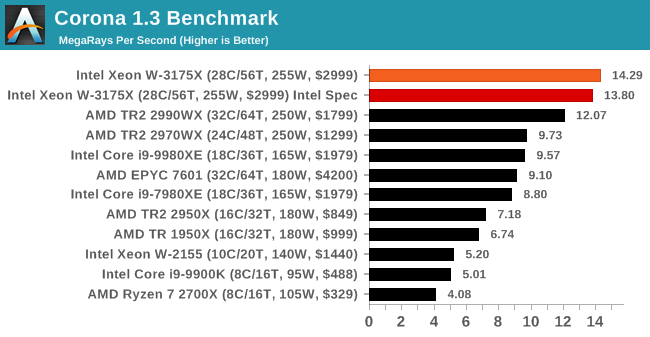
.
Blender 2.79b: 3D Creation Suite
A high profile rendering tool, Blender is open-source allowing for massive amounts of configurability, and is used by a number of high-profile animation studios worldwide. The organization recently released a Blender benchmark package, a couple of weeks after we had narrowed our Blender test for our new suite, however their test can take over an hour. For our results, we run one of the sub-tests in that suite through the command line - a standard ‘bmw27’ scene in CPU only mode, and measure the time to complete the render.
Blender can be downloaded at https://www.blender.org/download/
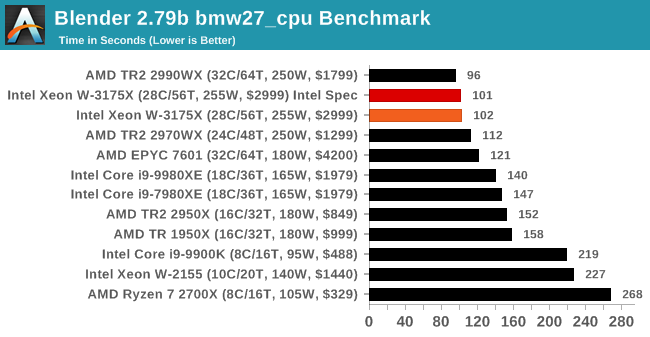
.
LuxMark v3.1: LuxRender via Different Code Paths
As stated at the top, there are many different ways to process rendering data: CPU, GPU, Accelerator, and others. On top of that, there are many frameworks and APIs in which to program, depending on how the software will be used. LuxMark, a benchmark developed using the LuxRender engine, offers several different scenes and APIs.
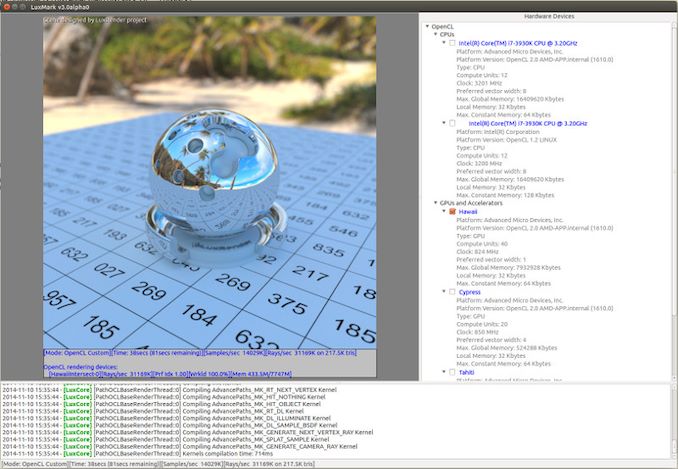
Taken from the Linux Version of LuxMark
In our test, we run the simple ‘Ball’ scene on both the C++ and OpenCL code paths, but in CPU mode. This scene starts with a rough render and slowly improves the quality over two minutes, giving a final result in what is essentially an average ‘kilorays per second’.
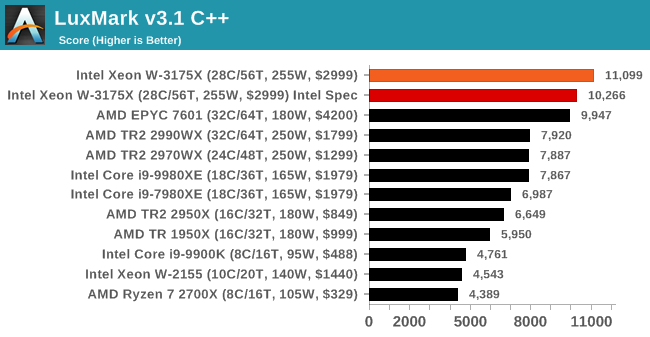
.
POV-Ray 3.7.1: Ray Tracing
The Persistence of Vision ray tracing engine is another well-known benchmarking tool, which was in a state of relative hibernation until AMD released its Zen processors, to which suddenly both Intel and AMD were submitting code to the main branch of the open source project. For our test, we use the built-in benchmark for all-cores, called from the command line.
POV-Ray can be downloaded from http://www.povray.org/
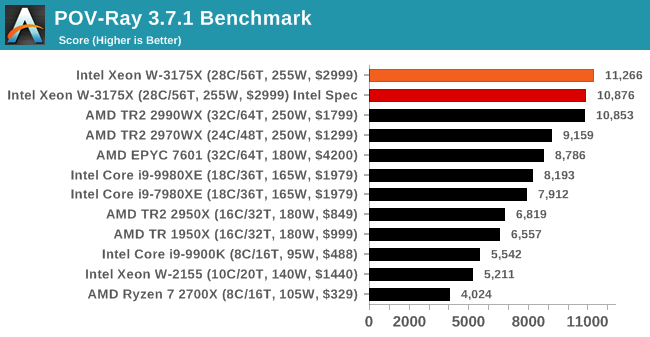
.











136 Comments
View All Comments
abufrejoval - Wednesday, January 30, 2019 - link
So with the limited edition production numbers, quite clearly the price can be symbolically low, just so Intel can claim bragging rights: They are not interested in satisfying market demands, especially since far too many workstation and server customers might switch over from a Xeon Scalable offering, they just want to claim victory... everywhere... including 10nmJust pathetic!
And honestly, you shouldn't even report about it. Your mission is to inform consumers on products they can buy. If consumers cannot buy it, you should treat it very, very differently, if at all.
You're just being abused by Intel to push a brand that suffers for reasons.
SH3200 - Wednesday, January 30, 2019 - link
This product cannibalizes half the current Xeon lineup as it provides ecc/rdimm at a fraction of the cost. I’d be amazed if FSI customers don’t prebuy every single one ever made before it even hits the public.br83taylor - Wednesday, January 30, 2019 - link
I find it odd Ian is happy to run and report benchmarks with this processor going against Intel recommendation for bios settings, yet would not do it for the AMD processors with their PBO setting. Both of which seem to do very similar things. Letting the 2990WX run with PBO would give it a much fairer chance against this.GreenReaper - Thursday, January 31, 2019 - link
It's not unressonablr to test the system as given to you, especially when it is provided as a complete system, so may represent what end-users get. That said, it seems like he kinda called that out in the sideways manner by highlighting the fact that the system Intel had shipped to him was not actually using those specifications.outsideloop - Wednesday, January 30, 2019 - link
This reminds me of the FX-9590. Massively overclocking silicon to keep up. Except now, the shoe is on the other foot.wow&wow - Wednesday, January 30, 2019 - link
Xeon W-3175X: $2999+$1500= $4499Ryzen TR 2900WX: $1799+$300= $2099
Is Intel trying to market it for “stupids” or those whose left brains being not right and right brains having nothing left :-D
ksec - Wednesday, January 30, 2019 - link
I think we need some new innovation in Thermal Cooling, how we could cool more with less, ease and cheaper. We pushed to near 600W for CPU and GPU alone.mapesdhs - Saturday, February 2, 2019 - link
Ye cannae beat the laws of physics. :D Thermal density is a hard problem. Check out AdoredTV's video on the subject, it explains things nicely.The_Assimilator - Wednesday, January 30, 2019 - link
This is Pentium 4 days all over again.bananaforscale - Thursday, January 31, 2019 - link
Kitty approves of heat output.